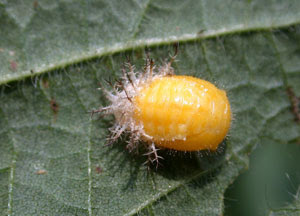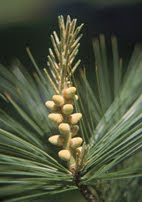We had a great day at the farmer's market!
Wednesday, August 18, 2010
Grand Haven Farmer's Market
Saturday, July 31, 2010
Monarch butterfly caterpillars
Now is the time to find the Monarch butterfly caterpillars! I hope that all of you get a chance to find some of these caterpillars and put them in a jar with holes in the lid and watch them go through metamorphosis. All you need to do is find a caterpillar and then put a few milkweed leaves in the container with the caterpillar for them to eat. If the milkweed dries out put a fresh one in. After a small amount of time- usually within a day or two the caterpillar will climb to the top of the container and build a chrysalis. Then within a 2 week time spand the chrysalis will go from light green to black and orange. The butterfly will emerge from the chrysalis and fly away like we saw at the gardens one day. I hope you each have fun and get to experience this wonder of nature.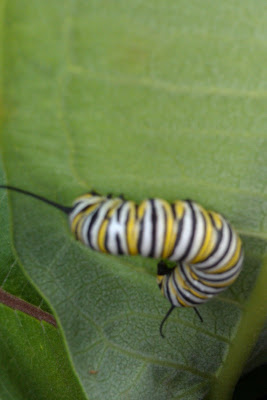

Wednesday, July 28, 2010
Found at Ed Garden: Mexican Bean Beetle
On Monday 7/26/10 a Master Gardener Volunteer found these cute-ugly creatures that look like a nib of moldy corn.
"What are these?" She asked, turning over the leaf of a bush bean.
"I will find out!" I declared.
It is the pupa of the Mexican Bean Beetle.
The Mexican bean beetle is actually a cousin of the ladybird beetle, one of the few destructive species of this primarily beneficial family of insects. The adult is oval shaped and copper colored, with 16 black spots on its back. It is about 5/16 inch long and 1/4 inch wide. Females lay yellow, oval-shaped eggs in clusters on the underside of bean leaves. From these eggs, hatch yellow larvae with branched spines that cover their soft bodies. There are 4 larval stages, the final one reaching a length of 1/3 inch, before transforming into a bright yellow pupae. The pupae are usually found attached to the underside of leaves.
The best way for us to control these beetles is simply to pick them off by hand and toss them into a bucket of soapy water. Or, if you like, squish them between your fingers!
"What are these?" She asked, turning over the leaf of a bush bean.
"I will find out!" I declared.
It is the pupa of the Mexican Bean Beetle.
The Mexican bean beetle is actually a cousin of the ladybird beetle, one of the few destructive species of this primarily beneficial family of insects. The adult is oval shaped and copper colored, with 16 black spots on its back. It is about 5/16 inch long and 1/4 inch wide. Females lay yellow, oval-shaped eggs in clusters on the underside of bean leaves. From these eggs, hatch yellow larvae with branched spines that cover their soft bodies. There are 4 larval stages, the final one reaching a length of 1/3 inch, before transforming into a bright yellow pupae. The pupae are usually found attached to the underside of leaves.
The best way for us to control these beetles is simply to pick them off by hand and toss them into a bucket of soapy water. Or, if you like, squish them between your fingers!
The Beautiful White Pine, Our State Tree
The pollen-bearing staminate (male) yellow flowers of White Pine emerge with the new shoots (candles) in mid-spring, and fertilize the nearby pistillate (female) flowers that become immature pinkish cones. White Pine is therefore a monoecious species, like all Pines.
By summer, the light green fruits (or cones) of White Pine show characteristic splotches of silvery-white that dapple their surfaces. With maturity, the six-inch long fruits become slightly curved, their scales reflex to release the hidden seeds, and the brown cones eventually fall to the ground. The slender cones of White Pine do not have prickles on the backside of their scales, as many pines do.
White Pine is distinctive as it reaches middle age, as its whorled branches and the spaces between them create a layered visual sight. With time, the top of the canopy becomes flat-topped or scalloped, and the middle of the canopy grows wider.
The gray-green bark of White Pine remains relatively smooth for a number of years, until it finally begins to develop furrows and ridges that are dark gray to dark brown. Sap drippings from the bark are often a common sight and turn white upon exposure to air.
Monday, July 26, 2010
We played a game with flowers and pollinators. The flowers had to guess what type of pollinator was circling them. We learned that there are many pollinators. A few of the pollinators that we talked about were beetles, honeybees, mosquitoes, butterflies, bats, hummingbirds, moths and the wind.

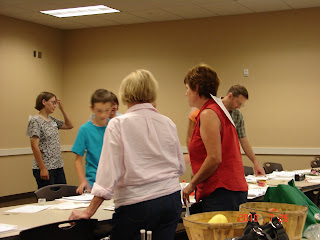
We learned the results of our soil test from last week. The color was a bluish green. We estimated that the PH was 6.5. We are going to get another soil test from Michigan State University and compare the two.

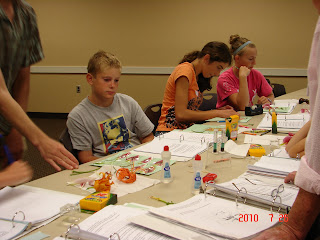





We learned the results of our soil test from last week. The color was a bluish green. We estimated that the PH was 6.5. We are going to get another soil test from Michigan State University and compare the two.
Thursday, July 22, 2010
Chrysanthemum Lace Bug
After carefully studying our Lace Bug samples under a table top microscope, I must change my opinion. These insects are not the Eggplant Lace Bug--Gargaphia solani--at all; they are the Chrysanthemum Lace Bug--Corythucha marmorata. This is logical as the Eggplant Lace Bug is more commonly found south and west of Michigan and the Chrysanthemum Lace Bug is widely spread across the U.S. and Canada.
According to Ohio State University, "The chrysanthemum lace bug has a wide host range. Aside from attacking its namesake and asters, this lace bug may also be found on goldenrod, Helianthus, Rudbeckia, and Tanacetum. This lace bug is unusual in that it lives on both the upper and lower leaf surfaces."
At the Education Garden, our Lace Bug specimens were found on the leaves of annual Helianthus, which is sunflower.
When you view the image of the Eggplant Lace Bug and compare it to the Chrysanthemum Lace Bug, what differences and similarities do you observe?
According to Ohio State University, "The chrysanthemum lace bug has a wide host range. Aside from attacking its namesake and asters, this lace bug may also be found on goldenrod, Helianthus, Rudbeckia, and Tanacetum. This lace bug is unusual in that it lives on both the upper and lower leaf surfaces."
At the Education Garden, our Lace Bug specimens were found on the leaves of annual Helianthus, which is sunflower.
When you view the image of the Eggplant Lace Bug and compare it to the Chrysanthemum Lace Bug, what differences and similarities do you observe?
Wednesday, July 21, 2010
Eggplant Lacebug
On July 19 at the Education Garden the kids collected this tiny critter, discovered on the back of a sunflower leaf. Looks like an Eggplant Lacebug. There are many different species of Lacebug, but they are given their common name due to their dainty, lace-like wings.
Adult - The prothorax (area behind the head) of this gray and light brown bug has a hood-like projection which extends out over the body and comes to a point over the wings. The bug has a dark head, pale yellow legs, and two pairs of lace-like wings which are black at the base. The body appears flattened and is about 4 mm long and 2 mm wide.
Egg - The 0.4-mm-long, oval-elongate egg appears almost bottle-shaped. Greenish at the base and brown toward the tip, the egg has a crater-like depression in one end with a white, lace-like border. All eggs in each roughly circular cluster are deposited on end and lean in different directions.
Nymph - About 2 to 3 mm long, the mature nymph is yellow with a dark spot at the tip of the abdomen. The boy is covered with spines.
BIOLOGY
Distribution - Eggplant lace bugs are most common from Maryland, Missouri, and Oklahoma southward. They occur west into New Mexico and Arizona and have also been reported in New Jersey, Pennsylvania, Connecticut, and British Columbia.
Host Plants - The eggplant lace bug has a narrow host range. Its food plants include eggplant, tomato, potato, sunflower, sage, cotton, and horsenettle.
Damage - Circular discolored areas about the size of a quarter are the first noticeable symptoms of lace bug damage. The remains of an egg mass and a group of nymphs typically are found on the underside of each discolored spot. Lace bugs gradually move outward until the whole leaf yellows and dries out. Feeding in groups, they move from leaf to leaf and eventually to new plants. A severe lace bug infestation may kill whole plants or weaken them to the point that fruit fails to develop.
Life History - Eggplant lace bugs overwinter as adults within shriveled leaves or among other plant debris. They emerge and lay eggs in mid- to late May. Each female spends 4 to 5 days depositing 100 to 200 eggs in a roughly circular mass on the underside of a leaf. The female guards her eggs against predators. When the eggs hatch about 6 days later, the female continues to guard her offspring. Nymphs feed and move as a colony, guided by the adult female. Molting every other day, nymphs develop through five instars and become adults in about 10 days. Several days may elapse before adults of the new generation mate and deposit more eggs. Approximately 6 annual generations occur on eggplant followed by one or two additional generations on horsenettle.
CONTROL
Eggplant lace bugs are preyed upon by lady beetle larvae and adults, spiders, and shield-shaped soldier bugs.Tuesday, July 20, 2010
Plants and Insects
Today we scouted for insects and attempted to identify them. Which ones are beneficial? The students found many pollinators and predators, such as different species of bees and wasps. They also found the Distinct Lace Bug, a Leaf-footed Bug, Monarch butterflies and Robber Flies. What they found in gross abundance, of course, were Japanese Beetles, which were picked off by nimble fingers and plunged into a bucket of water to drown without pity.
Subscribe to:
Posts (Atom)


